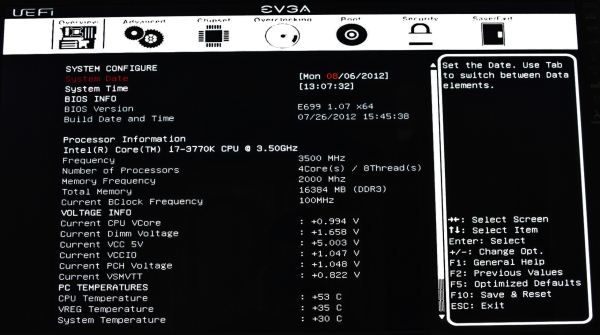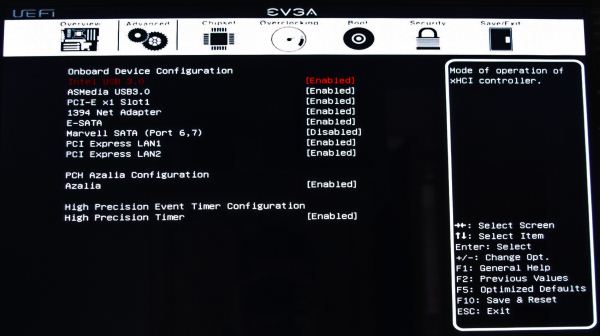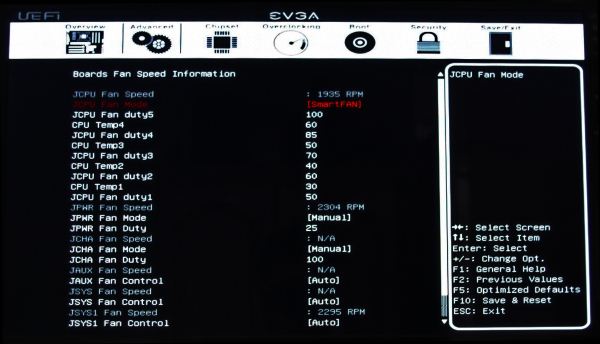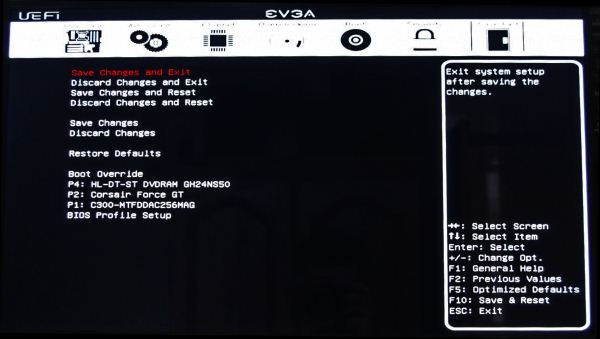Four Multi-GPU Z77 Boards from $280-$350 - PLX PEX 8747 featuring Gigabyte, ASRock, ECS and EVGA
by Ian Cutress on August 22, 2012 9:15 AM ESTEVGA Z77 FTW BIOS
There are a very few companies who have yet to make the switch from a plain interface BIOS to the new wave of graphical interaction. EVGA is in this boat – while their BIOS is technically a UEFI, it still relies on keyboard controls and simple menu selections in order to get the options correct. Any semblance of an easy screen for all the basic information and/or fan controls are out of the window here, users have to explore to find the options they want, alongside a ton of options to which I have no clue what they do.
It should be noted at this juncture that the BIOS for the EVGA Z77 FTW currently follows Intel specifications for CPU Turbo implementation, such that for an i7-3770K we have 39x/39x/38x/37x multipliers for 1/2/3/4 core loading. Some other motherboard manufacturers use what ASUS call ‘MultiCore Enhancement’, which gives 39x/39x/39x/39x multipliers under the respective loading for better performance at the expense of increased heat, temperature, and potential longevity. EVGA will be implementing this feature in a later BIOS, however for our review we were locked into BIOS 1.07, the latest available on the EVGA website at the time of testing.
I would also like to note that the BIOS does not have a print screen function, so I apologize in advance for the potential poor quality of the upcoming BIOS images taken with a cheap $600 DSLR without a tripod.
Our first BIOS screen, while not graphical, contains the wealth of information I would expect from every manufacturer on the market. We have access to the BIOS version and build date, the processor being used as well as speed and cores/threads, memory speeds and amounts, and voltages/temperatures of the important components of the motherboard. Despite not being the most well presented set of information possible, it does satisfy the criteria needed by system builders, integrators and debuggers without needing to open the system and pry the CPU cooler off / install an operating system.
As long as the BIOS is updated from the early betas, we get a system which enables AHCI for the SATA ports by default, which is always beneficial. Unwanted controllers can be disabled through one of the ‘Onboard Devices’ sub-menu under ‘Advanced’. The EVGA Z77 FTW POST time benefits a great deal if the Marvell SATA controllers are unused, dropping from 19.55 seconds to 11.21 seconds when everything is disabled.
Fan controls are found under the ‘Advanced’ menu. We have access through the BIOS to a complex multi-point fan control system (no mention of gradients) that allows users to select a direct correlation between temperatures and fan speeds under the CPU header. Unfortunately this control is not provided through software as well, which is a shame given that these controls outshine some of the ones provided by top-tier manufacturers.
EVGA has a history of overclocking records – not surprising, as they have had on staff over the years some of the world’s most famous extreme overclockers, including Vince ‘Kingpin’ Lucido and Tsemenko ‘TiN’ Ilya. So when it comes to the overclocking section of their top line Z77 motherboard, we might expect some fantastic new features to help.
On the first main screen we get all the important CPU options – CPU multiplier control, LLC (VDroop) control, OCP (Over-Current Protection), Performance Teaks, and important CPU and system voltages. One feature worth explicitly mentioning is the OC Mode option – this is ideal for competitive overclockers, as it automatically disables all non-essential controllers on board to maximize stability. I like this feature.
Memory options are found in the ‘Memory Configuration’ menu, which give access to apply XMP profiles, or manual settings across the ranges. EVGA tell me that they have recently been working hard to ensure that XMP functionality will work across a wide range of kits, however my aggressively timed memory kit (DDR3-2400 9-11-11) that I use for Z77 reviews failed to register, neither would it work with additional VTT voltage. As a result, we had to run the kit at DDR3-2000 9-11-11 for our testing, which is not much of a difference in our testing suite.
C-State options are under the CPU configuration menus, and the BCLK adjustment is performed through its own menu. BCLK adjustment could easily be moved into the main OC menu with the multiplier adjustment, and my attempts at manipulating the BCLK heavily were not that successful – while most motherboards will happily boot with 108 MHz on my i7-3770K, the EVGA board was happy only at 104 MHz. I am unsure as to why this is the case, when I have seen results for the Z77 FTW hitting 108 MHz+.
The EVGA BIOS also comes with Boot Override, allowing for a single-time boot from specified device.





















24 Comments
View All Comments
goinginstyle - Thursday, August 23, 2012 - link
I tried the G1 Sniper 3 and returned it a few days later. The audio was a significant downgrade from the Assassin series, EFI is clunky at best and the board had serious problems with a GSKill 16GB 2666 kit, not to mention the lousy fan controls.Purchased a Maximus Formula V and never looked back as the EFI, Fan Controls, Clocking and Audio are much better in every way compared to the Sniper board. There is no way Gigabyte has brought better value than ASUS with the Z77 chipset. You get what you pay for and the GB is overpriced once you actually use the board and compare it to ASUS or even ASRock.
JohnBS - Thursday, November 1, 2012 - link
I am looking for a rock solid MB, so of course I turned to ASUS. However, the reviews from verified buyers showed multiple issues with 3.0 USB ports losing power, system instability after months of use, and multiple instances of the board not working in one or more memory slots. Bent pins from the factory and complete DOA issues as well. A few reports of complete failure when the Wi-Fi card was inserted, yet gone with the card removed. This was mainly the Maximus IV series. Then I thought I'd look into the Maximus V series, because I really wanted ASUS, and was kinda sad to read reviews. Same issues from verified buyers of the Maximus V, more so with the USB 3.0 problems and the Wi-Fi/Bluetooth add-on card failures. In common were multiple complaints about customer service.So I emailed the ASUS rep who was replying to everyone's post, with specific attention on the recurring problems and how I was concerned about buying a MB. I got the email back, stating they were aware of the recurring problems listed on the user reviews, but that they are isolated occurrences.
I really need a rock solid x16 x 2 pci-e mb right now, and that's why I'm still searching. I'm planning on overclocking an i7-2700k with an gtx 690 and a 120z monitor for high res gaming. The sniper 3 looks good, but the front audio plug reaching the board's bottom audio header might be something I can't work around.
Just want something reliable. If there's a known issue, I'm always in that percentile that gets hit with the RMA process. I'm trying so hard to avoid that.
(Went with 690 instead of dual 680 for heat, noise, power draw considerations).
jonjonjonj - Friday, October 26, 2012 - link
you mean gigabyte in the evga conclusion?"the EVGA does not keep pace with ASUS and EVGA even at stock speeds."
couchassault9001 - Friday, November 2, 2012 - link
So for gaming benchmarks is it correct that the cpu multipliers were at 40 on the g1.sniper and 36 on the evga? if so it seems to be a rather unfair comparison. Being that the sniper cpu is running 11% fasterI'd be amazed if someone was looking at these boards with no intent to overclock like crazy, as i'm trying to decide between these 2 boards myself, and i'm sure i'll be pushing my 3770k as far as it will go.
The evga consumed ~8% less power than the sniper under load.
dirt 3 showed a 9% frame rate drop in the frame rate going from g1 to evga. metro 2033 showed a 3.6% drop in frame rate going from g1 to evga. Both of these are on the 4 7970 benchmarks. the 3 and below the gap is much tighter with it being under 1% with one card.
I know this may be nit picking to some, but i plan on running 5760x1080 3d so 4 7970 performance on a i7-3770k is exactly what i'm looking at.